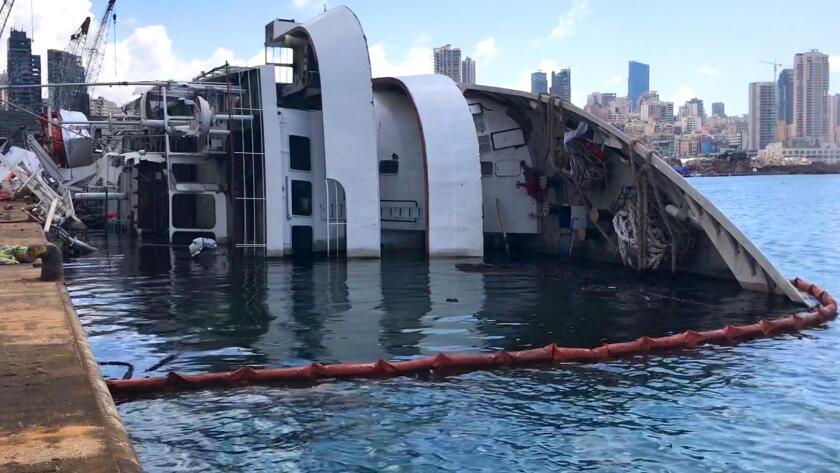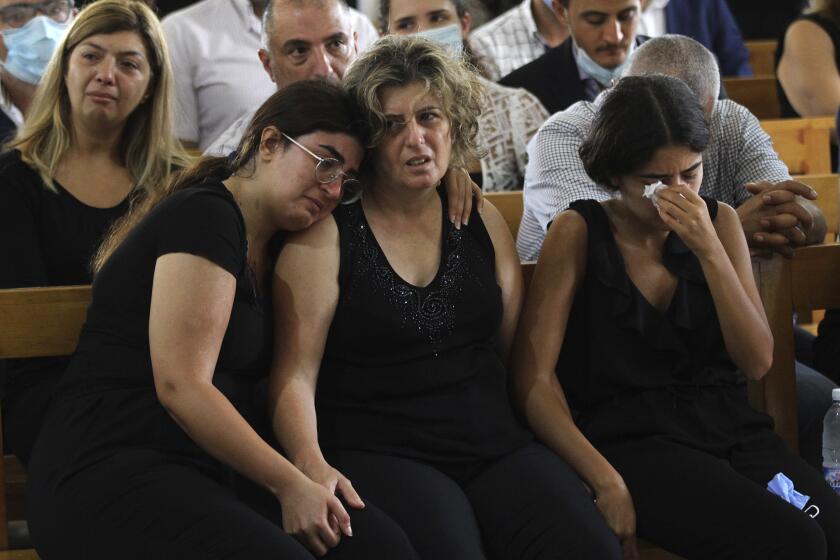‘Everything has been pulverized,’ but cleanup and investigation of Beirut blast press on
- Share via
- Share via
BEIRUT — To understand the catastrophic destruction wrought by the Aug. 4 detonation of 2,750 tons of ammonium nitrate in Beirut’s port, don’t look at the 45-foot-deep crater at the explosion’s epicenter. Instead, go a third of a mile to the east.
There, near the skeletal husk of Warehouse 21, clumps of impossibly twisted metal and mangled concrete show how the force of the blast seemed to warp even the laws of physics. It catapulted a Toyota hatchback three feet into the air before smashing it atop a concrete barrier. It flicked a heavy Mercedes truck and trailer like a bothersome fly into one of the warehouse’s pillars. At the nearby pier, it flipped the 396-foot-long Orient Queen cruise ship onto its side and cracked open its upper decks, where the guts of the Reflections Bar that once served “midnight exotic cocktails” are on grotesque display.
Beyond the port, entire neighborhoods instantly became derelict, and skyscrapers turned into giant shards of jagged glass and ripped cladding.
Two weeks after the monumental explosion that registered as a magnitude 3.3 earthquake and was felt as far as Cyprus, a full accounting of the cataclysmal event and its precise cause has yet to be given. So far, about 180 people are dead, more than 6,000 are wounded, dozens remain missing and countless lives have been shattered.
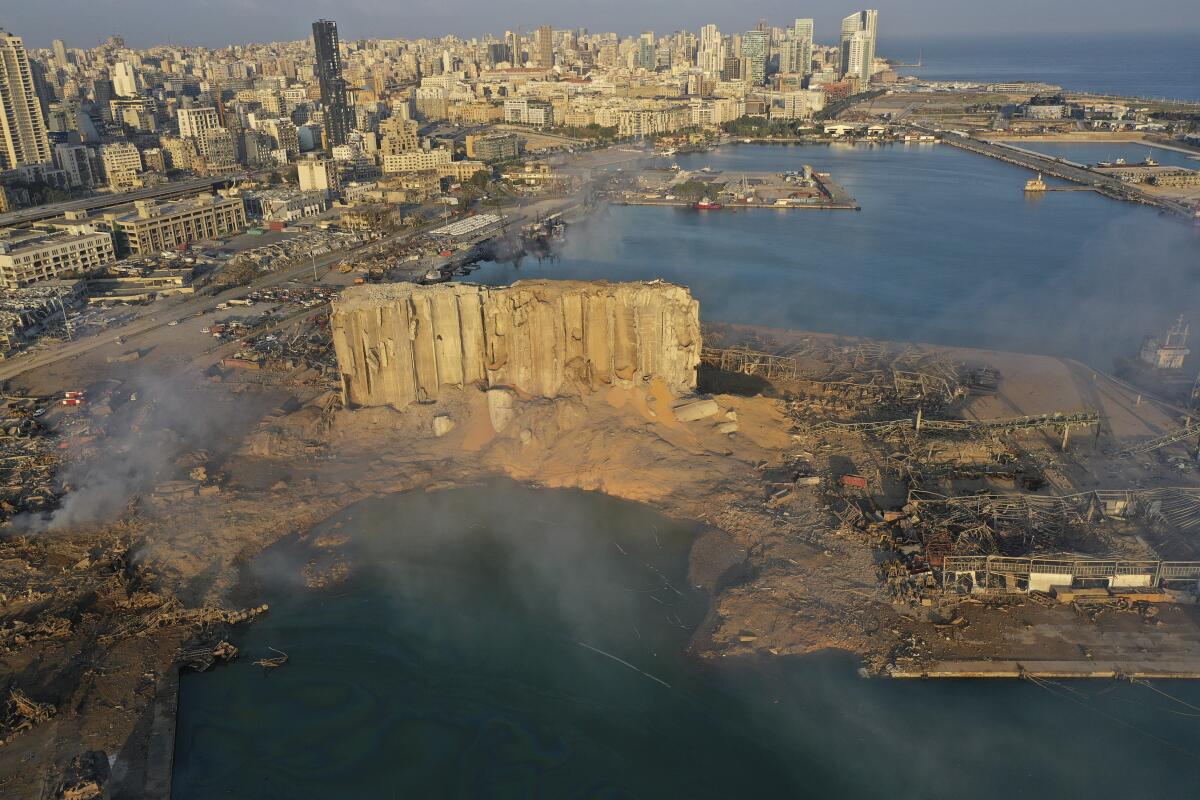
The arduous, agonizing cleanup operation is still underway, concentrated most intensely in the port area, where Lebanese and international teams continue to hunt for clues to what happened and for bodies in the debris, which includes mountains of grain disgorged from the port’s silos. (They once held 85% of Lebanon’s grain.) The teams are also charged with restarting operations at what was the entry point for almost two-thirds of Lebanon’s imports.
“We’re working within a 54-yard radius 24 hours a day. First it was search and rescue, but now it’s really search, so we can help the families bury their loved ones,” said Lt. Andrea, who heads the French military’s search and rescue team. He declined to give his last name, in accordance with French military regulations.
By Monday, 13 days after the blast, workers had found all but one of the 10 firefighters initially dispatched to the port to tackle the warehouse blaze that apparently triggered the blast. But there were fears that the silos, which were heavily damaged, could collapse.
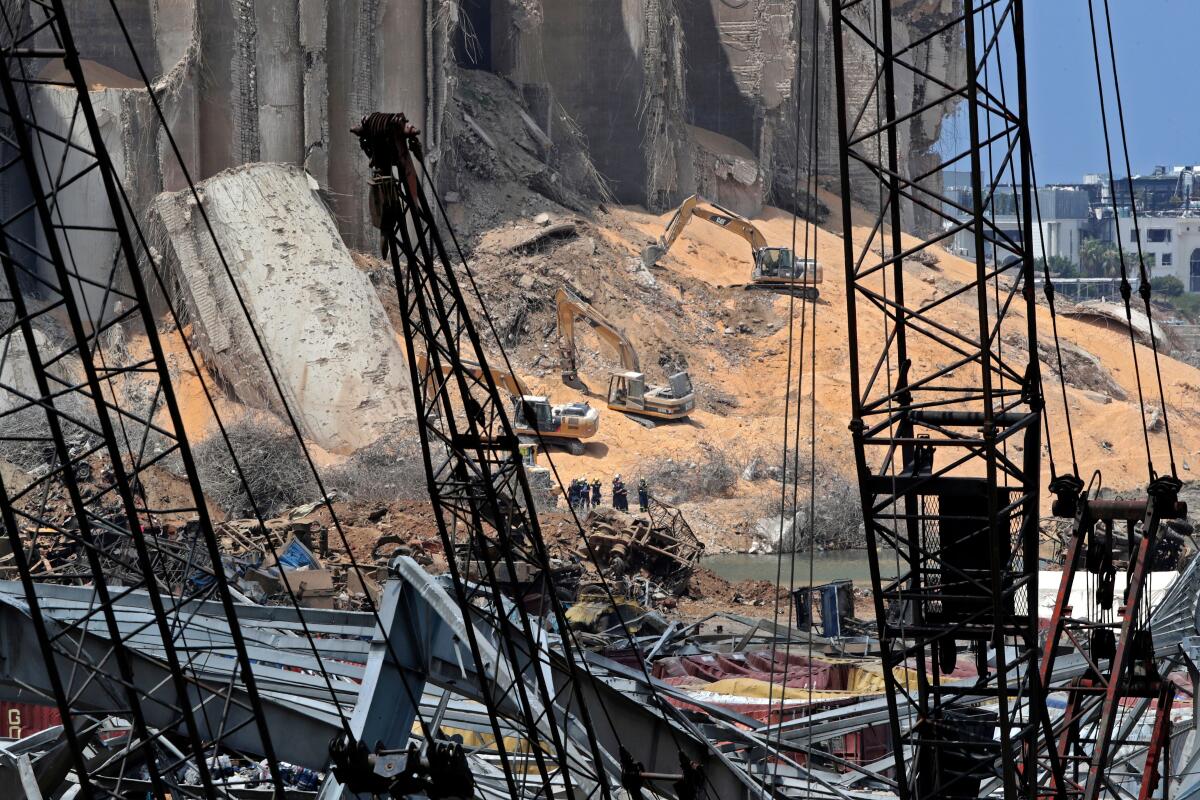
“We’re still searching, but we’ve brought in engineers to assess their structural integrity and see if we can continue,” said a Lebanese civil defense officer, who did not give his name because he was not authorized to speak to the media.
“We’re still looking for a 30-ton firetruck we can’t find,” he added. “It’s like it was vaporized.”
Complicating the mammoth cleanup and investigative effort is the ever-present dust that cloaks the workers and that could be a toxic soup of who-knows-what chemicals and particles.
Through tears in Beirut, Lebanese survivors share stories of missing loved ones
“It’s a roulette wheel as to what was shoved up into the air and scattered in dust all over the place.... From a toxicology standpoint it’s a shop of horrors,” said Dan Kaszeta, a London-based chemical and security defense consultant. “The concern is the mystery products, what was in the adjacent warehouses, or simple things like sheet metal and coatings. When you start adding up tons of it getting shredded and put into dust form, it’s a big mess.”
Last week, Lebanon’s CBRN unit, the governmental group responsible for dealing with chemical hazards, reported the safe removal of a number of materials from the area, including flammable liquids as well as what were described as unsafe combinations of fuels and oxidizers.
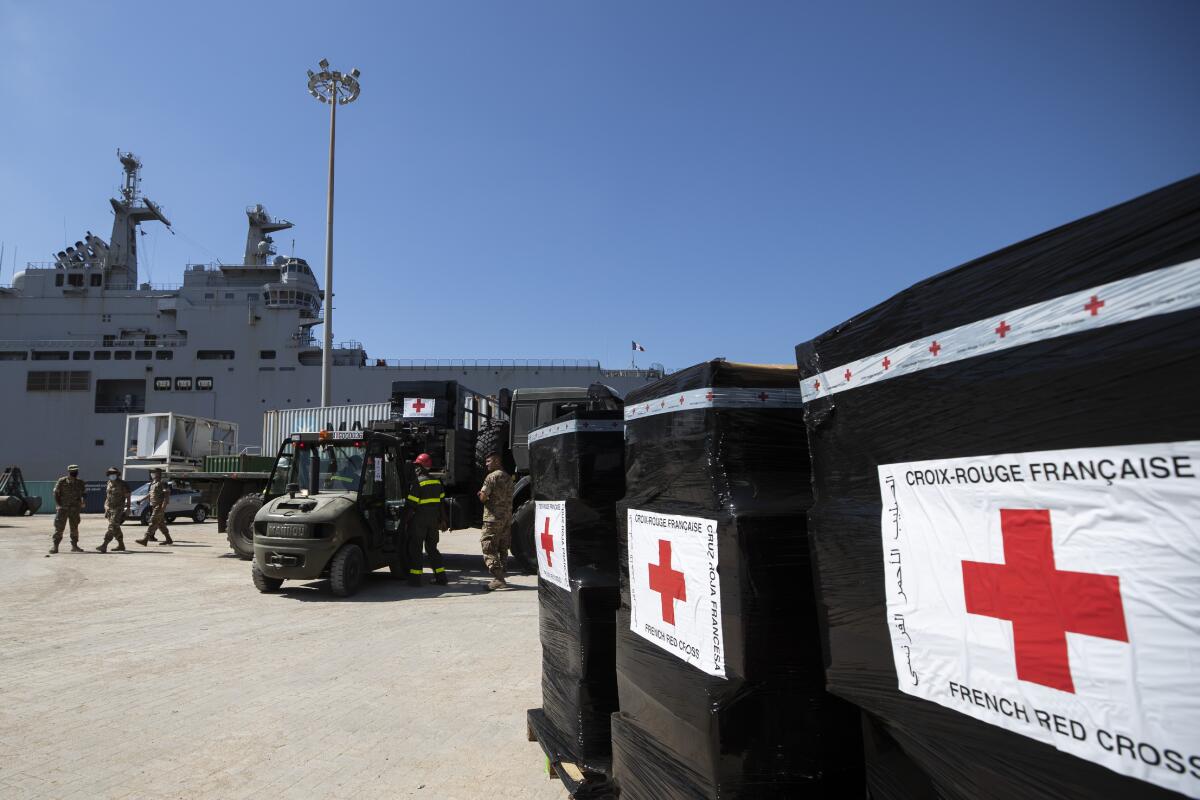
Behind Warehouse 21, a contingent of French emergency workers prepared their equipment near a cluster of shipping containers. One of the workers, a chemical expert and team leader named Lt. Anthony, donned his blue hazmat suit and approached a damaged container, one of its sides opened to reveal two rows of sealed boxes. A drone hovered nearby as he knelt and examined them.
“We analyze these containers for leaks,” he said, noting that 18 containers in his sector contained hazardous materials. “In normal conditions it’s not dangerous. But some of the materials are flammable, and we have to check after the blast.”
Similar difficulties face the chemical and forensic experts collecting samples for analysis that they hope will shed light on how the disaster began.
“The first and main technical difficulty is the magnitude of the explosion — everything has been pulverized,” said Fabien Tabarly, director of NIGMA Conseil, a Beirut-based security consulting and intelligence firm. “It’s going to be very hard, because everything that is of interest has probably disappeared.”
Then there’s the grim search for human remains.
Down a path cleared amid the rubble, an excavator rumbled over a mound of churned-up earth where a ruined car lay partially buried.

Ahmad Jumaa, the excavator’s operator, maneuvered the claw over the mound, then used it to grab the side of the car and extricate it from the dirt’s embrace. He gave the car a shake to dislodge loose earth and set it down before a group of civil defense workers and French forensic police.
A skilled excavator operator with decades of experience, Jumaa worked quickly, recovering more pieces of wreckage for examination. But after more than 30 nerve-racking minutes, no bodies were found; the search dogs that had twice flagged the site had evidently caught a whiff of rotting juice boxes.
Restoring historic districts badly damaged in the Beirut blast will be a tall order given Lebanon’s weak economy and developers’ eagerness to move in.
“There are so many smells here,” said Jumaa. “We just don’t know what we’ll find. It’s difficult work.”
A few dozen yards away, a team of Qatari military personnel stepped gingerly through a patch of debris, poking at the ground with pieces of rusted rebar.
“We’re not finding whole corpses, but body parts,” one officer said.
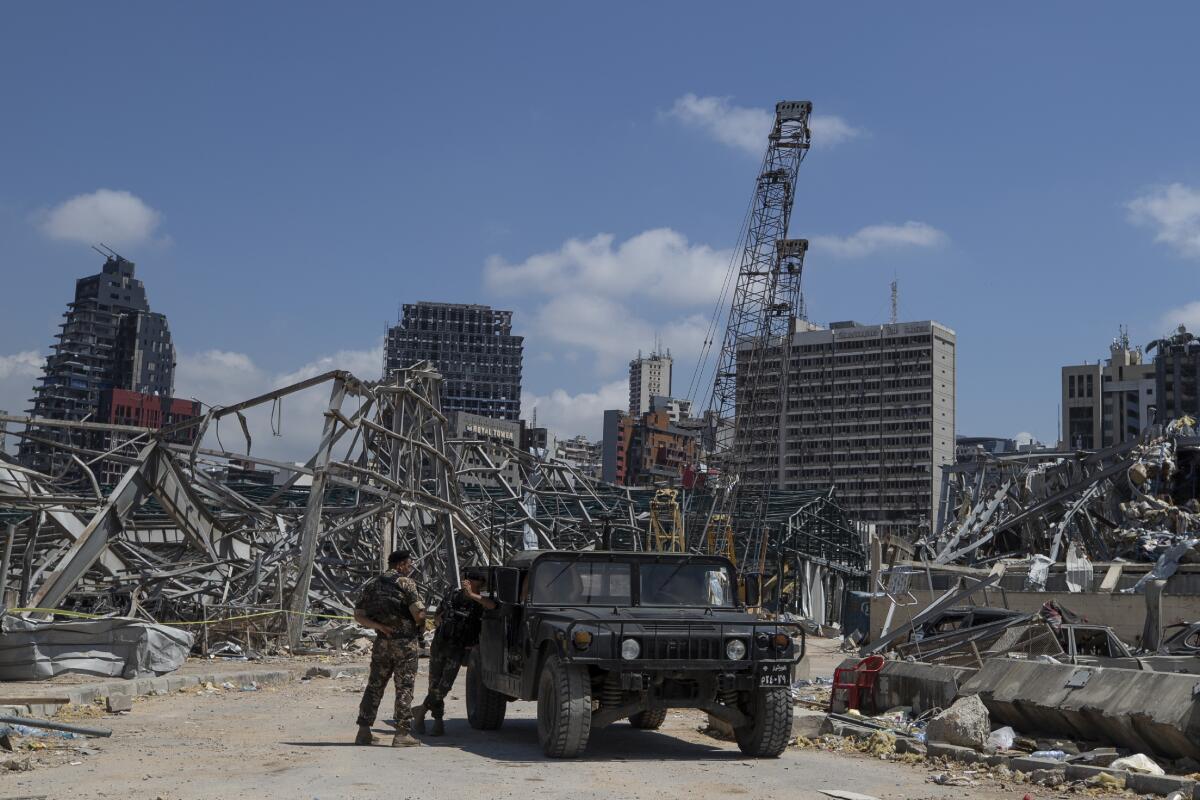
Moments later, one of his colleagues carefully lifted a ragged-looking heavy-duty glove. “You can smell decomposing flesh here,” he said, wrinkling his nose.
Amid all the depressing markers of death and decay, there has been at least one ray of hope: The port, against all expectations, is semi-operational again.
By last Wednesday, 12 of its 16 cranes were operating, according to Raoul Nehme, Lebanon’s caretaker economics minister. This week, CMA CGM, a French container transport and shipping company, said in a statement that two of its ships had already been to the port since the blast and were unloaded without incident.
“Our vessels schedule to Beirut port resumed normally,” the company said.
Nehme said that grain shipments were also restarting, with 127,000 tons of flour expected for delivery in the coming weeks.
“There is no crisis in [flour] stocks nor a bread crisis!” he tweeted happily.
The words offer, almost literally, crumbs of comfort to those who have lost loved ones, homes, jobs. But for now, as Beirutis try to salvage their lives and cleanup crews try to salvage their beloved city, they’ll have to do.
More to Read
Sign up for Essential California
The most important California stories and recommendations in your inbox every morning.
You may occasionally receive promotional content from the Los Angeles Times.
